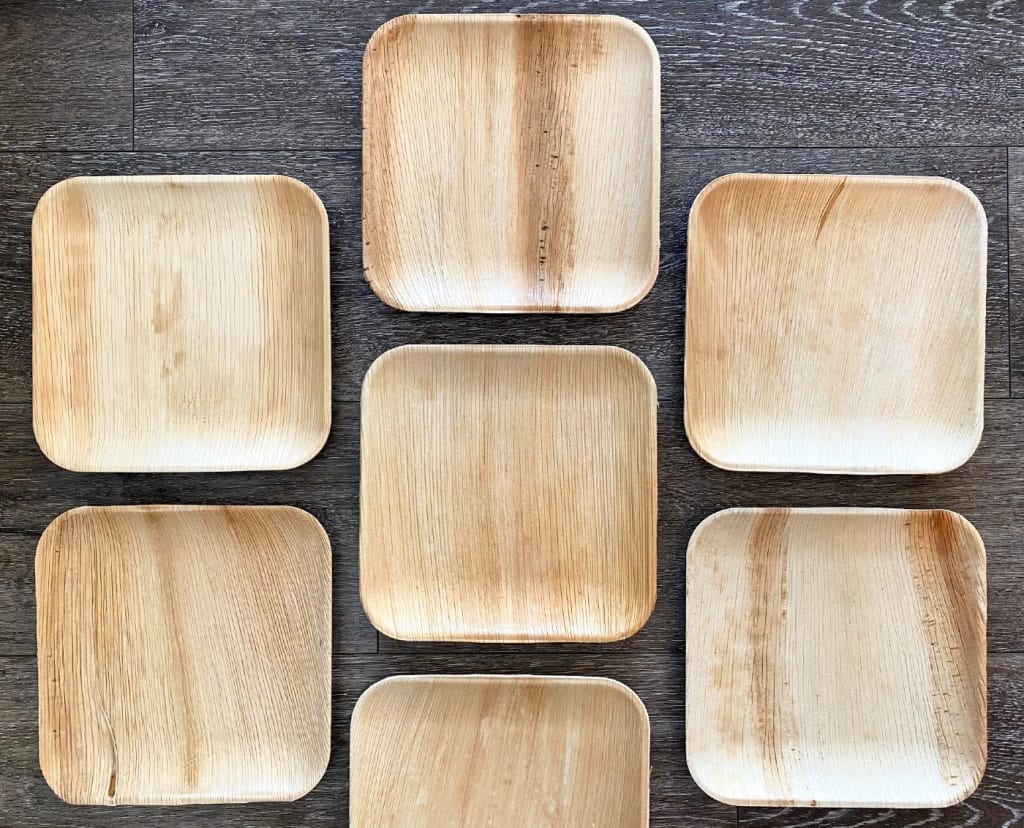Are Palm Leaf Plates Compostable? CanapeKing
Palm Leaf Plates, Bowls in Bulk

In recent years, the quest for sustainable alternatives to traditional disposable tableware has led to the rise in popularity of palm leaf plates. These plates, made from fallen leaves of the areca palm tree, offer a biodegradable and eco plates option for serving food at various events and gatherings.
This comprehensive discussion explores the compostability of palm leaf plates, delving into their production process, environmental benefits, composting guidelines, and considerations for widespread adoption.
Production Process of Palm Leaf Plates
Sourcing Raw Materials
Palm leaf plates are crafted from naturally fallen leaves of the areca palm tree (scientifically known as Areca catechu), which is native to tropical regions such as India and Southeast Asia. The leaves are harvested after they naturally fall from the tree, eliminating the need for additional resources or deforestation. This sustainable sourcing method ensures minimal environmental impact and supports local economies where the trees grow abundantly.
Manufacturing Process
The manufacturing of palm leaf plates involves a straightforward and eco-friendly process:
1. Collection: Fallen palm leaves are collected from the ground. This step involves gathering leaves that are intact and free from damage.
2. Cleaning and Sterilization: The collected leaves are thoroughly cleaned to remove any dirt or impurities. They are then sterilized using natural methods, such as hot water or steam, to ensure they are safe for use with food.
3. Molding and Shaping: After sterilization, the leaves are pressed into molds using heat and pressure. This process gives the plates their shape and structure without the need for additional chemicals or additives.
4. Trimming and Finishing: Once molded, the plates are trimmed to remove any rough edges and polished to enhance their appearance and smoothness.
5. Packaging: The finished palm leaf plates by Canapeking are then packaged and ready for distribution.
The entire production process is notable for its minimal environmental impact, as it does not involve harmful chemicals or excessive energy consumption. The use of fallen leaves as raw materials also contributes to the sustainability of palm leaf plates.
Environmental Benefits of Palm Leaf Plates
Biodegradability
One of the most significant environmental benefits of palm leaf plates is their biodegradability. Unlike plastic or styrofoam alternatives, which can persist in the environment for hundreds of years, palm leaf plates break down naturally and rapidly under composting conditions. This characteristic reduces the burden on landfills and contributes to the nutrient cycle by returning organic matter to the soil.
Compostability
Palm leaf plates are not only biodegradable but also compostable. Composting is a natural process where organic materials decompose into nutrient-rich soil amendments, known as compost. Palm leaf plates, when disposed of in a composting environment, decompose within a few months, depending on environmental conditions such as temperature, moisture, and microbial activity.
Soil Enrichment
The compost resulting from palm leaf plates enriches the soil with essential nutrients, improving its fertility and water retention capacity. This nutrient-rich soil can support healthy plant growth and reduce the need for chemical fertilizers, further benefiting agricultural sustainability.
Low Carbon Footprint
The production of palm leaf plates has a low carbon footprint compared to conventional plastic or paper products. The manufacturing process requires minimal energy input and does not emit greenhouse gases in significant quantities. Additionally, since the raw materials are sourced locally and sustainably, the carbon emissions associated with transportation and processing are minimized.
Sustainable Sourcing Practices
The use of fallen palm leaves promotes sustainable sourcing practices by utilizing a natural byproduct of the palm tree's lifecycle. This approach avoids the environmental impacts of deforestation and reduces waste by repurposing materials that would otherwise decompose naturally on the forest floor.
Composting Guidelines for Palm Leaf Plates
Composting palm leaf plates is a straightforward process, but certain guidelines ensure optimal decomposition and environmental benefits:
1. Prepare the Plates: If the plates have been used for serving food, ensure they are free from any residues or contaminants. Rinse them with water if necessary, but avoid soaking them.
2. Break Down: For faster decomposition, tear the plates into smaller pieces. This increases the surface area exposed to microbial activity, speeding up the composting process.
3. Layering: Place the torn palm leaf pieces in your compost bin or heap. Alternate layers of palm leaf plates with other organic materials, such as fruit and vegetable scraps, to maintain a balanced compost pile.
4. Moisture and Aeration: Ensure the compost pile remains moist but not waterlogged. Regularly turn or aerate the pile to promote oxygen flow, which aids decomposition.
5. Temperature and Time: Composting works best in warm conditions. Monitor the temperature of your compost pile, aiming for a range of 120 to 160 degrees Fahrenheit (49 to 71 degrees Celsius), to facilitate microbial activity. Palm leaf plates typically decompose within 2 to 6 months under optimal conditions.
6. Finished Compost: Once fully decomposed, the palm leaf plates will transform into dark, crumbly compost that resembles rich soil. Use this compost to enrich your garden soil or donate it to local community gardens.
Considerations for Widespread Adoption
While palm leaf plates offer numerous environmental benefits and are compostable, several considerations may influence their widespread adoption:
- Consumer Awareness: Educating consumers about the benefits of palm leaf plates and proper composting techniques is crucial for encouraging their use.
- Infrastructure: Availability of composting facilities and municipal programs that accept palm leaf plates for composting can facilitate their disposal in an environmentally responsible manner.
- Cost and Accessibility: While palm leaf plates are competitively priced, their availability and cost-effectiveness may vary regionally. Economies of scale and increased demand could potentially lower costs over time.
- Regulatory Support: Government policies and incentives promoting composting and sustainable alternatives to plastic can support the adoption of palm leaf plates on a broader scale.
Conclusion
In conclusion, palm leaf plates are not only biodegradable but also compostable, making them a sustainable choice for disposable tableware. Their production from fallen palm leaves and their ability to enrich soil through composting contribute to environmental sustainability.
By following proper composting guidelines and promoting awareness of their benefits, palm leaf plates can play a significant role in reducing plastic waste and supporting a circular economy. As consumer preferences shift towards eco-friendly alternatives, palm leaf plates offer a practical solution that aligns with global efforts to mitigate environmental impact and promote sustainable living.
About the Creator
Abdul Haseeb Kamal
I am a SEO Analyst/Dr. Web/Expert. Having 6+ Years of Experience of On-page and Off-page SEO and Able to Use Blogs, Online Forum/Communities, HARO, Skyscraper, Outreach and Social Media Platforms and Uses Highly-Targeted website Content.
Enjoyed the story? Support the Creator.
Subscribe for free to receive all their stories in your feed. You could also pledge your support or give them a one-off tip, letting them know you appreciate their work.






Comments
Abdul Haseeb Kamal is not accepting comments at the moment
Want to show your support? Send them a one-off tip.